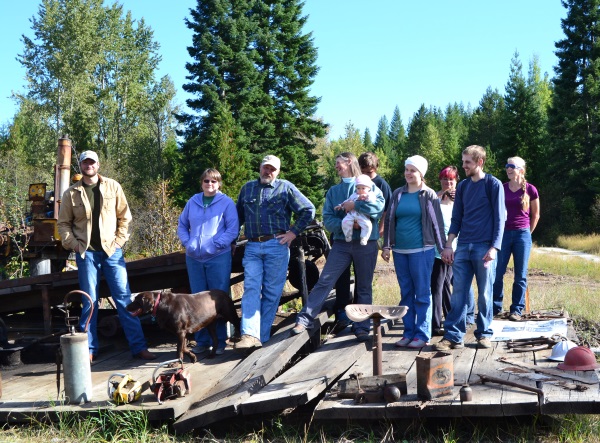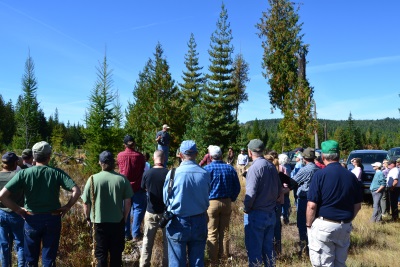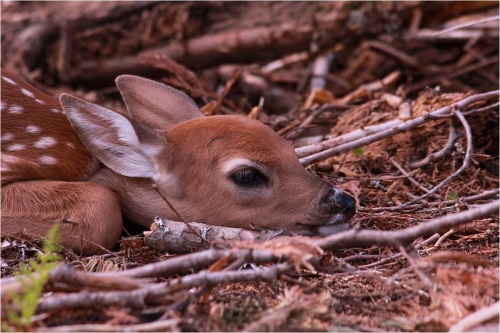Lyle and Linda Fitchett of Idaho

What makes them outstanding?
The property that comprises the Fitchett Tree Farm has been owned by the Fitchett family since shortly after World War II. As Mickey Fitchett once wrote about her husband, Win(fred) used his muster pay from his release out of the Navy and borrowed $500.00 from his father, Frank Fitchett and in 1949 bought the 920 acres of timberland. (The Co-op Country Round Up, July 2005) Possession of this once cutover timberland has been in the Fitchett family ever since.
Win Fitchett tragically died from a logging accident on the Tree Farm in 1996; but not before instilling a strong stewardship ethic in his son, Lyle (Rusty) and daughter Ruby. Together, this brother/sister team oversees the Tree Farm operation. As active managers of on-going timber harvesting, Rusty fells and skids while Ruby processes the logs at the landing. (Now you understand why the word active is underlined in the previous sentence.)
The original Tree Farm, once owned by Win and Mickey Fitchett, now consists of five separate Tree Farms owned by various family members. Win and Mickey’s children, grandchildren, and now great grandchildren all take part in management activities.
As you read more about the Fitchett Tree Farm, you will understand why the Idaho Tree Farm Committee recognized the Fitchett Family as the Idaho Outstanding Tree Farmer of the Year in 2014. The committee hopes that you will consider them for recognition as the Western Regional and National Outstanding Tree Farmer of the Year for 2015.
Tree Farmer Story
 During its 2014 Annual Meeting last March, the
Idaho Tree Farm Committee recognized the Fitchett Family Tree Farm as Idaho’s
Outstanding Tree Farmer of the Year.
Lyle (Rusty) Fitchett, his wife Linda, his sister, Ruby Bartlett, along
with several of their children and grandchildren accepted the award. But receiving equal acknowledgement by both
the nominating foresters and the family were Rusty and Ruby’s parents, Winfred
and Mickey Fitchett. That was important
because you cannot mention one generation of the Fitchett family without
describing them all.
During its 2014 Annual Meeting last March, the
Idaho Tree Farm Committee recognized the Fitchett Family Tree Farm as Idaho’s
Outstanding Tree Farmer of the Year.
Lyle (Rusty) Fitchett, his wife Linda, his sister, Ruby Bartlett, along
with several of their children and grandchildren accepted the award. But receiving equal acknowledgement by both
the nominating foresters and the family were Rusty and Ruby’s parents, Winfred
and Mickey Fitchett. That was important
because you cannot mention one generation of the Fitchett family without
describing them all.
The story of the Fitchett Family Tree Farm begins in the winter of 1947-48. Not long after mustering out of the U.S. Navy, Win Fitchett hired on to split cedar fence posts on a cutover tract of land northeast of Sandpoint, Idaho.
Many years later, Win described the situation as follows: “The loggers running the show were just interested in timber not land. In talking with him he said, We will give you a good deal, but need three more years to get it logged off.’ I said, ‘how good?’ Well there is 920 acres here and if you can come up with the $1,800 cash to make our equipment payment, we will deed it all to you, ok?’
Win shook the piggy bank pretty hard to come up with the money. Three years later it was time for Win and his bride, Mickey, to move onto the property.
Win continues,“Time of exodus had come. There it was in a tangle of scrap lumber, garbage heap, broken cable, chokers (the remains of the logging camp) OUR FUTURE. Two buildings left - an outhouse and a cedar bark shed used to park the cat. By night it had changed into Home Sweet Home. Complete with smoke out of the pipe of a little cook stove Couple of dynamite boxes nailed on the wall for kitchen cupboards, the bed set up and leveled, a full bucket of water from the creek, kerosene lantern, and we had each other. Went back after the sawmill the next day.”
The Fitchett Family Tree Farm “ both family and trees - grew out of those humble beginnings. The Tree Farm sits on a highly productive site but the timber had been high-graded to the point that very little merchantable timber remained. Win’s original intention called for converting this former timber stand into a northern Idaho stump ranch to raise cattle. But the trees grew and grew so Win concentrated on running his Bel Saw circular sawmill to produce lumber for the local community. His logging equipment consisted of a converted Word War II era Army 6x6 truck.
Mickey helped out in both the woods and sawmill operations. As they grew older, both Rusty and Ruby contributed as well. Grandchildren later contributed. Now great grandchildren are involved.
Silvicultural treatments in those years were simple: hunt and peck over the 900 acres to find enough logs to match the lumber orders. In the meantime, dense stands of young growth trees filled every opening. The ideal time to precommercially thin the understory should have occurred in the 1960’s. But this treatment was delayed until the 1980’s when cost-share assistance became available. While this thinning certainly helped, it tended to be too little too late.

Fast forward a couple of decades to about 2005. Rusty decided to leave his day job as a logger to concentrate on managing the family Tree Farm. His sister, Ruby, joined him. They figured on continuing the familiar sanitation/salvage silvicultural treatment that had carried the stand for over four decades. But long-time high school friend, Tom Johnson, changed their minds. Now a service forester with the Idaho Department of Lands, Tom knew the property well enough to convince Rusty that more thinning wasn’t the answer. Regeneration cuts were needed to establish the next crop of trees that could better utilize the site’s productive potential. Every stand reaches the point where it is time to start over. Moreover, modern economics could not justify high logging costs for low volumes per acre. Chasing the dead and dying trees to capture the mortality would not pencil out anymore. Rusty and Ruby adopted a more aggressive silvicultural approach and upgraded their equipment to be efficient as well.
Timber harvesting drives other silvicultural treatments on the Tree Farm. The first clearcuts from a decade ago were immediately followed by reforesting with white pine and larch, the two preferred species on this site. All family members participated in the tree planting. More recently clearcuts and seed tree cuts are relying on natural regeneration to reforest the site. So far, this strategy has resulted in well-stocked conditions without the costs of planting.
White pine saplings, both natural and planted, are being pruned to reduce the risk white pine blister rust infection.The earliest regeneration cuts will be ready for precommercial thinning within the next five years. This time around, these treatments will not be deferred. While most of the modern treatments can be easily explained, one small area defies any logical silivcultural explanation. One of Rusty and Linda’s sons needed a little extra money for his upcoming honeymoon. He was assigned about five acres of timber to generate the needed income. The Fitchetts now refer to this as the honeymoon stand and wonder, what was that kid thinking? But, in time, the silviculture will make sense.
The Fitchett Tree Farm is a story of a forest and a family. The two cannot be separated through rotations of trees or generations of family. That is why the Idaho Tree Farm Committee recognized the Fitchetts as Outstanding Tree Farmers of the Year. That is why they should be considered for Western Regional and National Outstanding Tree Farmers of the Year.
Wood
As the family tells the story, timber attracted Win Fitchett to this property in the first place. And, nearly seven decades later, it is still the timber that is important to the family. After purchasing the cut-over property in 1948, Win intended for it to become a cattle operation. Son Rusty described the situation as follows, Dad bought the property to turn it into pasture and wanted to raise cattle, he had put in 600 acres of fencing, but he just could not keep up with the trees that grew back, so his pasture and cattle operation did not come about even though he had been logging since 1952. (The Co-op Country Round Up, July 5, 2005)
Indeed, the trees grew back on this productive site, forming a two-storied stand. The overstory consisted of scattered low-quality, low-valued trees left from previous timber harvests. The understory filled in with dog hair stands of mixed conifers. Over the early decades, Win Fitchett conducted what amounted to overstory removal/sanitation-salvage harvests. These highly defective trees had little merchantable value at the big sawmills but Win used his keen eye for merchantability to capture every possible board on his circular sawmill. Many a structure in the Gold Creek area was built using Win by lumber salvaged from the Fitchett Tree Farm.
About ten years ago, Rusty decided to focus his logging career on the Fitchett Tree Farm rather than on other ownerships. He reasoned; why drive across the county to a logging job when a full-time job awaited him right out his back door? Not long after that, sister Ruby joined him on the logging crew.
The annual timber harvest has averaged 100,000-125,000 board feet per year for the past decade and helps support two families.
Water
The Idaho Panhandle is abundantly rich in water resources with lakes, streams and rivers enriching much of the landscape. As expected, this almost 900 acre Tree Farm contains water resources; primarily in the form of small streams.
Johnson Creek and several of its tributaries flow across the Fitchett Tree Farm. Beaver dams have formed ponds on one of the tributary streams.
Timber harvests are conducted in a manner to protect water quality and meet or exceed the best management practices required in the Idaho Forest Practices Act. Road maintenance activities include rocking, cross-ditching and placing culverts where needed to prevent sediment delivery to streams. Gating of roads reduces the risk of trespass that could lead to water quality problems.
Wildlife
Wildlife is an important objective on the Fitchett Tree Farm. With almost 900 acres of forestland, this Tree Farm is sufficiently large enough to provide a diversity of wildlife habitat. In particular, management for big game species including whitetail deer, elk, moose and bear receives emphasis. However, small mammals, birds, reptiles and amphibians also share the benefit of intensive forest management practices.
Win Fitchett acquired this tract as heavily cutover timberland in the late 1940’s. Its many openings favored shrubs and other browse species that benefitted big game and other open-space wildlife species. Over the years, however, dense, closed-canopy forests shaded out the sun-loving plants preferred by big game animals. While these stands provided ideal hiding and thermal cover, they offered minimal food value. Regeneration harvests, including clearcuts and seed tree cuts, conducted over the last decade have created openings that once again attract big game animals. The highly desirable edge-effect benefits many species of wildlife by providing openings alongside dense forest.
Observing the favorable results of forest management practices benefitting wildlife habitat has inspired the Fitchett family to create food plots for wildlife. Normally considered a southern forestry practice, the establishment of food plots specifically to attract wildlife is uncommon in the intermountain west.
The placement of game cameras throughout the Tree Farm has become an educational activity for the Fitchett family to enjoy the variety of wildlife that inhabits their Tree Farm. Not only do they enjoy capturing wildlife on film, but observing the animals’ patterns has begun to influence the Fitchett’s forest management decisions with an eye toward improving habitat.
Recreation
Fortunately the Fitchett family considers physical work as a form of recreation. With that in mind, recreational opportunities abound on this almost 900 acre Tree Farm. Family sweat equity activities have included tree planting, thinning, firewood cutting and road maintenance.
Work aside, every family member has their own way of playing on the Tree Farm. For some, an afternoon of hunting provides relaxation as well as an opportunity for sustenance. For others, saddling up the family’s horses for a ride produces both enjoyment along with an inventory of the Tree Farm’s miles of roads and trails. All family members enjoy visits to the small cabin located by the beaver ponds near the center of the property.
All activities - both work and play require keeping an eye out for the abundance of wildlife that also make their home on the Tree Farm.
When you own almost 900 acres, you will not have to search far to find pretty spots. Travel up to the eastern ridge and enjoy the 360 degree view. Venture down to the beaver ponds for views of a different type. The recently harvested areas contrast in an aesthetically pleasing manner with the dense stands of timber.


